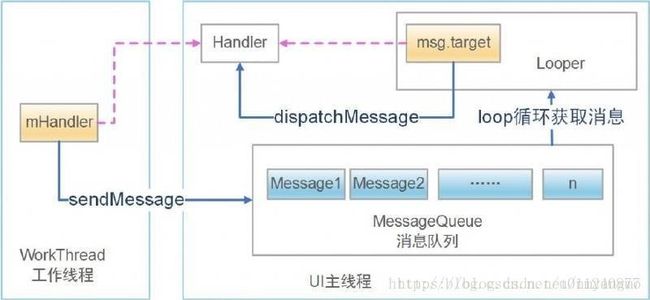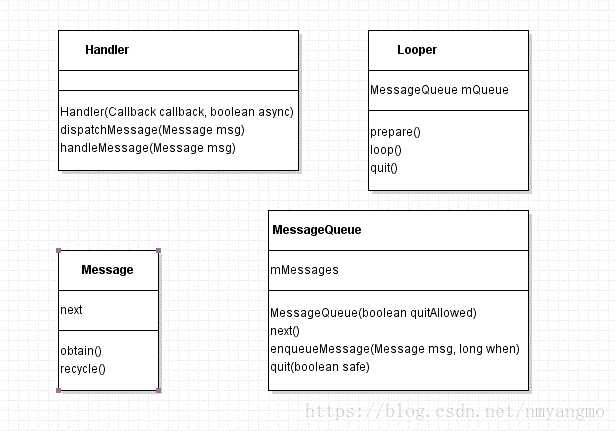Handler消息机制,讲解Handler、Message、MessageQueue、Looper之间的关系
什么是handler?
Handler是进程内部、线程间的一种通信机制。
Handler、Looper、MessageQueen、Message的关系
Message: 消息对象
MessageQueen: 存储消息对象的队列
Looper:负责循环读取MessageQueen中的消息,读到消息之后就把消息交给Handler去处理。
Handler:发送消息和处理消息
源码解析
要想使用handler ,首先要保证当前所在线程存在Looper对象
主线程不需要主动创建Looper对象是因为主线程已经为你准备好了,详见android.app.ActivityThread->Looper.prepareMainLooper()
我们创建的子线程如果想用handler接收数据,需要先通过Looper.prepare()创建Looper
Looper.prepare();
...//创建Handler并传入
Looper.loop()
Looper类
Looper构造方法
private Looper(boolean quitAllowed) {
mQueue = new MessageQueue(quitAllowed);
mThread = Thread.currentThread();
}
创建Looper对象的时候,同时创建了MessageQueue,并让Looper绑定当前线程。但我们从来不直接调用构造方法获取Looper对象,而是使用Looper的prepare()方法
prepare()使用ThreadLocal 保存当前Looper对象,ThreadLocal 类可以对数据进行线程隔离,保证了在当前线程只能获取当前线程的Looper对象,同时prepare()保证当前线程有且只有一个Looper对象,间接保证了一个线程只有一个MessageQueue对象
Looper的prepare()
private static void prepare(boolean quitAllowed) {
if (sThreadLocal.get() != null) {
throw new RuntimeException("Only one Looper may be created per thread");
}
sThreadLocal.set(new Looper(quitAllowed));
}
Looper开启循环
public static void loop() {
final Looper me = myLooper();
if (me == null) {
throw new RuntimeException("No Looper; Looper.prepare() wasn't called on this thread.");
}
final MessageQueue queue = me.mQueue;
Binder.clearCallingIdentity();
final long ident = Binder.clearCallingIdentity();
for (;;) {
Message msg = queue.next(); // might block 也许会堵塞,一会在next方法中解析
if (msg == null) {
return;
}
try {
msg.target.dispatchMessage(msg);
} finally {
if (traceTag != 0) {
Trace.traceEnd(traceTag);
}
}
msg.recycleUnchecked();
}
}
Lopper通过loop()开启无限循环,通过MessageQueue的next()获取message对象。一旦获取就调用msg.target.dispatchMEssage(msg)将msg交给handler对象处理(msg.target是handler对象),最后回收
Handler类
Hanlder实例化
public Handler(Callback callback, boolean async) {
mLooper = Looper.myLooper();
if (mLooper == null) {
throw new RuntimeException(
"Can't create handler inside thread that has not called Looper.prepare()");
}
mQueue = mLooper.mQueue;
mCallback = callback;
mAsynchronous = async;
}
实例化过程中获取当前线程的MessageQueue对象,以便于将消息加入MessageQueue
发送消息
public boolean sendMessageAtTime(Message msg, long uptimeMillis) {
MessageQueue queue = mQueue;
if (queue == null) {
RuntimeException e = new RuntimeException(
this + " sendMessageAtTime() called with no mQueue");
Log.w("Looper", e.getMessage(), e);
return false;
}
return enqueueMessage(queue, msg, uptimeMillis);
}
将消息加入队列
private boolean enqueueMessage(MessageQueue queue, Message msg, long uptimeMillis) {
msg.target = this;
if (mAsynchronous) {
msg.setAsynchronous(true);
}
return queue.enqueueMessage(msg, uptimeMillis);
}
enqueueMessage中首先为msg.target赋值为this,为发送消息出队列交给handler处理埋下伏笔。
处理消息
public void dispatchMessage(Message msg) {
if (msg.callback != null) {
handleCallback(msg);
} else {
if (mCallback != null) {
if (mCallback.handleMessage(msg)) {
return;
}
}
handleMessage(msg);
}
}
前面我们提到Looper.loop()获取到消息时会调用handler的dispatchMessage方法进行处理,handler处理消息就是调用我们重写的handleMessage()方法,或者我们可以在创建Handler实例时实现Callback接口,一样可以处理从MessageQueue出来的消息
MessageQueue类
MessageQueue 构造方法
MessageQueue(boolean quitAllowed) {
mQuitAllowed = quitAllowed;
mPtr = nativeInit();
}
MessageQueue初始化过程同时初始化底层的NativeMessageQueue对象,并且持有NativeMessageQueue的内存地址(long)
MessageQueue的next()
Message next() {
final long ptr = mPtr;
if (ptr == 0) {
return null;
}
int pendingIdleHandlerCount = -1; // -1 only during first iteration
int nextPollTimeoutMillis = 0;
for (;;) {
if (nextPollTimeoutMillis != 0) {
Binder.flushPendingCommands(); //刷一下,就当是Android系统的一种性能优化操作
}
nativePollOnce(ptr, nextPollTimeoutMillis);//native底层实现堵塞,堵塞状态可被新消息唤醒,头一次进来不会延迟
synchronized (this) {
final long now = SystemClock.uptimeMillis();
Message prevMsg = null;
Message msg = mMessages;//获取头节点消息
if (msg != null && msg.target == null) {
do {
prevMsg = msg;
msg = msg.next;
} while (msg != null && !msg.isAsynchronous());
}
if (msg != null) {
if (now < msg.when) {
nextPollTimeoutMillis = (int) Math.min(msg.when - now, Integer.MAX_VALUE);//获取堵塞时间
} else {
mBlocked = false;
if (prevMsg != null) { //头结点指向队列中第二个消息对象
prevMsg.next = msg.next;
} else {
mMessages = msg.next;
}
msg.next = null;
if (DEBUG) Log.v(TAG, "Returning message: " + msg);
msg.markInUse();
return msg; //直接出队列返回给looper
}
} else {
nextPollTimeoutMillis = -1;//队列已无消息,一直堵塞
}
if (mQuitting) {
dispose();
return null;
}
pendingIdleHandlerCount = 0;
nextPollTimeoutMillis = 0;
}
}
虽然looper也开启了循环,但是到了真正干活的时候它却调用了MessageQueue的next(),要想搞明白怎么个堵塞,先看这三个对应的条件
nextPollTimeoutMillis=0 不堵塞
nextPollTimeoutMillis<0 一直堵塞
nextPollTimeoutMillis>0 堵塞对应时长,可被新消息唤醒
next()中,因为消息队列是按照延迟时间排序的,所以先考虑延迟最小的也就是头消息。当头消息为空,说明队列中没有消息了,nextPollTimeoutMIllis就被赋值为-1,当头消息延迟时间大于当前时间,堵塞消息要到延迟时间和当前时间的差值
当消息延迟时间小于等于0,直接返回msg给handler处理
nativePollOnce(ptr, nextPollTimeoutMillis)方法是native底层实现堵塞逻辑,堵塞状态会到时间唤醒,也可被新消息唤醒,一旦唤醒会重新获取头消息,重新评估是否堵塞或者直接返回消息
消息入栈enqueueMessage()
boolean enqueueMessage(Message msg, long when) {
if (msg.target == null) {
throw new IllegalArgumentException("Message must have a target.");
}
if (msg.isInUse()) {
throw new IllegalStateException(msg + " This message is already in use.");
}
synchronized (this) {
if (mQuitting) {
IllegalStateException e = new IllegalStateException(
msg.target + " sending message to a Handler on a dead thread");
Log.w(TAG, e.getMessage(), e);
msg.recycle();
return false;
}
msg.markInUse();
msg.when = when;
Message p = mMessages;
boolean needWake;
if (p == null || when == 0 || when < p.when) {
// New head, wake up the event queue if blocked.
msg.next = p;
mMessages = msg;
needWake = mBlocked;
} else {
// Inserted within the middle of the queue. Usually we don't have to wake
// up the event queue unless there is a barrier at the head of the queue
// and the message is the earliest asynchronous message in the queue.
needWake = mBlocked && p.target == null && msg.isAsynchronous();
Message prev;
for (;;) {
prev = p;
p = p.next;
if (p == null || when < p.when) {
break;
}
if (needWake && p.isAsynchronous()) {
needWake = false;
}
}
msg.next = p; // invariant: p == prev.next
prev.next = msg;
}
// We can assume mPtr != 0 because mQuitting is false.
if (needWake) {
nativeWake(mPtr);
}
}
return true;
}
消息入栈时,首先会判断新消息如果是第一个消息 或者 新消息没有延迟 或者 新消息延迟时间小于队列第一个消息的,都会立刻对这个消息进行处理。只有当消息延迟大于队列头消息时,才会依次遍历消息队列,将消息按延迟时间插入消息队列响应位置。
Message类
Message 初始化
public static Message obtain() {
synchronized (sPoolSync) {
if (sPool != null) {
Message m = sPool;
sPool = m.next;
m.next = null;
m.flags = 0; // clear in-use flag
sPoolSize--;
return m;
}
}
return new Message();
}
建议使用obtain()获取Message对象,因为Message维护着一个消息池,这个消息池的数据结构是单向链表,优先从池子里拿数据,如果池子里没有再创建对象。如果Message对象已存在,可以使用obtain(msg)方法,最终也会调用obtain()
消息的回收
void recycleUnchecked() {
flags = FLAG_IN_USE;
what = 0;
arg1 = 0;
arg2 = 0;
obj = null;
replyTo = null;
sendingUid = -1;
when = 0;
target = null;
callback = null;
data = null;
synchronized (sPoolSync) {
if (sPoolSize < MAX_POOL_SIZE) {
next = sPool;
sPool = this;
sPoolSize++;
}
}
}
消息的回收不是将Message对象销毁,而是将Message对象的值恢复初始值然后放回池子,等待使用
因为android会频繁的使用Message的对象,使用“池”这种机制可以减少创建对象开辟内存的时间,更加高效的利用内存,因此"池"这种机制被应用于频繁大量使用的类对象的情况,我们常说的“线程池”也是基于同样的原理。

总结: 要想在当前线程使用handler机制,首先确保当前线程存在Looper
**Looper.parper()创建一个 当前线程的Looper对象,同时创建一个MessageQueue对象 **
每个线程只有一个Looper对象和一个MessageQueue对象
Looper.loop()开始循环,没有msg情况下进入堵塞状态(-1)
Message对象最好通过Message.obtain()获得
Handler发送消息进入队列,如果没有延迟唤醒堵塞 Looper获得msg ,调用msg.targe.dispachMessage处理消息
关闭Activity如果栈中有未出栈的message,需清除handler.removeMessage(int)
子线程不再使用handler时,要调用loop.quit(),loop.quitSafely()
虽然表面上看是looper循环队列,并将msg给handler,但实际上是MessageQueue的next()去完成的,MessageQueue同时还承担消息的入队列,并对消息按照延迟时间从小到大进行了排序。鉴于MessageQueue如此大的工作量,在Android 2.3版本后,MessageQueue中next()方法的堵塞机制转移到了native层去处理,也就是我们使用的nativePollOnce(ptr, nextPollTimeoutMillis)方法
本篇博文没有分析屏障逻辑(msg.target==null),以及底层的堵塞逻辑,也没有分析异步消息逻辑(msg.isAsynchronous()==true)
